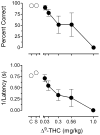A novel touch-sensitive apparatus for behavioral studies in unrestrained squirrel monkeys
- PMID: 22790109
- PMCID: PMC3429786
- DOI: 10.1016/j.jneumeth.2012.06.028
A novel touch-sensitive apparatus for behavioral studies in unrestrained squirrel monkeys
Abstract
Despite the increasing sophistication and affordability of touch-sensitive technology, its use in the behavioral sciences has been limited. The present paper describes the design and empirical validation of a novel touch-sensitive operant conditioning chamber for use with unrestrained squirrel monkeys. In addition, results from a variant of a commonly employed animal model of learning, the repeated acquisition task, demonstrate the effectiveness of this chamber in programming an assay of complex behavior. Finally, results from a study with Δ(9)-tetrahydrocannabinol, the active ingredient in marijuana, show that its effects in this novel touchscreen chamber were consistent with its dose-related effects on learning using more conventional approaches. Overall, these studies indicate the touchscreen apparatus provides effective means for programming complex behavioral tasks to assess the effects of pharmacological agents on cognitive function.
Copyright © 2012 Elsevier B.V. All rights reserved.
Figures






Similar articles
-
Touchscreen technology in the study of cognition-related behavior.Behav Pharmacol. 2017 Dec;28(8):623-629. doi: 10.1097/FBP.0000000000000356. Behav Pharmacol. 2017. PMID: 29064843 Free PMC article. Review.
-
Effects of environmental and pharmacological manipulations on a novel delayed nonmatching-to-sample 'working memory' procedure in unrestrained rhesus monkeys.J Neurosci Methods. 2015 Aug 15;251:62-71. doi: 10.1016/j.jneumeth.2015.05.009. Epub 2015 May 21. J Neurosci Methods. 2015. PMID: 26003863 Free PMC article.
-
Strain-dependent effects on acquisition and reversal of visual and spatial tasks in a rat touchscreen battery of cognition.Physiol Behav. 2015 May 15;144:26-36. doi: 10.1016/j.physbeh.2015.03.001. Epub 2015 Mar 3. Physiol Behav. 2015. PMID: 25744936
-
The opioid antagonist naltrexone reduces the reinforcing effects of Delta 9 tetrahydrocannabinol (THC) in squirrel monkeys.Psychopharmacology (Berl). 2004 Apr;173(1-2):186-94. doi: 10.1007/s00213-003-1693-6. Epub 2003 Dec 11. Psychopharmacology (Berl). 2004. PMID: 14668977
-
Translational cognitive neuroscience of dementia with touchscreen operant chambers.Genes Brain Behav. 2021 Jan;20(1):e12664. doi: 10.1111/gbb.12664. Epub 2020 Aug 18. Genes Brain Behav. 2021. PMID: 32374080 Review.
Cited by
-
Touchscreen technology in the study of cognition-related behavior.Behav Pharmacol. 2017 Dec;28(8):623-629. doi: 10.1097/FBP.0000000000000356. Behav Pharmacol. 2017. PMID: 29064843 Free PMC article. Review.
-
Discrimination learning in oxycodone-treated nonhuman primates.Drug Alcohol Depend. 2020 Feb 1;207:107778. doi: 10.1016/j.drugalcdep.2019.107778. Epub 2019 Nov 27. Drug Alcohol Depend. 2020. PMID: 31816487 Free PMC article.
-
Macaque monkeys learn and perform a non-match-to-goal task using an automated home cage training procedure.Sci Rep. 2021 Jan 29;11(1):2700. doi: 10.1038/s41598-021-82021-w. Sci Rep. 2021. PMID: 33514812 Free PMC article.
-
Implementation of automated cognitive testing systems for socially housed rhesus (Macaca mulatta) and squirrel (Saimiri spp.) monkeys: Age differences in learning.J Comp Psychol. 2025 May;139(2):124-133. doi: 10.1037/com0000391. Epub 2024 Sep 9. J Comp Psychol. 2025. PMID: 39250237
-
Interference and shaping in sensorimotor adaptations with rewards.PLoS Comput Biol. 2014 Jan;10(1):e1003377. doi: 10.1371/journal.pcbi.1003377. Epub 2014 Jan 9. PLoS Comput Biol. 2014. PMID: 24415925 Free PMC article.
References
-
- Abel EL. Marihuana and memory: Acquisition or Retrieval? Science. 1971;173:1038–1040. - PubMed
-
- Catania AC. Learning. 4. New Jersey: Prentice Hall; 1998.
-
- Darley CF, Tinklenberg WT, Roth JR, Hollister LE, Atkinson RC. Influence of marihuana on storage and retrieval processes in memory. Mem Cognition. 1973a;1:196–200. - PubMed
-
- Darley CF, Tinklenberg WT, Roth JR, Hollister LE, Atkinson RC. Marihuana and retrieval from short-term memory. Psychopharmacologia (Berl) 1973b;29:231–38. - PubMed
-
- Delatte MS, Paronis CA. Evaluation of cannabinoid agonists using punished responding and midazolam discrimination procedures. Psychopharmacology. 2008;198:521–28. - PubMed
Publication types
MeSH terms
Substances
Grants and funding
LinkOut - more resources
Full Text Sources

